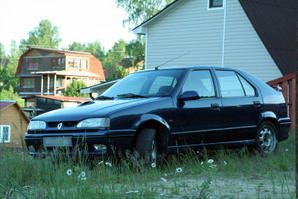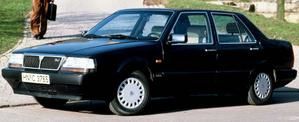The collaborations of car companies on various projects have led to very interesting outcomes which I would like to point out now and develop later when I do find the time.
The success stories were achieved in cases where the companies were complementary and also meaning that they were lacking in some aspects. Here are cases which come from my experience driving these cars.
First case study - Renault and Volvo
Here is the typical car that Volvo was known for: the Volvo 740.
 This car was structurally very strong. Through years of experiments, Volvo became the safest cars. The reason for that is simple: they have the reputation of making the most reliable trucks. On the other hand, as you can see on this picture, the performance of these cars was poor. They could not hold the road better than a typical US built car. In summary: they drove more like a truck. It even looks very classical, especially designed for the american market.
This car was structurally very strong. Through years of experiments, Volvo became the safest cars. The reason for that is simple: they have the reputation of making the most reliable trucks. On the other hand, as you can see on this picture, the performance of these cars was poor. They could not hold the road better than a typical US built car. In summary: they drove more like a truck. It even looks very classical, especially designed for the american market.
Here is a typical Renault of the same era, the Renault 25
 This car was like most cars made by Renault: very fun to drive. Renault made it a high-tech car with its talking computer always seeing problems when they were not. Not extremely reliable, but it did hold the road incredibly well (I did cross the Alps several times during winter and I could verify how good the car was). A nervous sports car-like machine, without the big power plants of the german competition. It was designed to be practical with its hatchback but this did not please the rich buyers outside of France who do not think about those issues. Everything in this car was unconventional and made it only sellable to France or very open-minded liberal. It even was used to make the Eagle Premier which was surely the best performance sedan made by Chrysler.
This car was like most cars made by Renault: very fun to drive. Renault made it a high-tech car with its talking computer always seeing problems when they were not. Not extremely reliable, but it did hold the road incredibly well (I did cross the Alps several times during winter and I could verify how good the car was). A nervous sports car-like machine, without the big power plants of the german competition. It was designed to be practical with its hatchback but this did not please the rich buyers outside of France who do not think about those issues. Everything in this car was unconventional and made it only sellable to France or very open-minded liberal. It even was used to make the Eagle Premier which was surely the best performance sedan made by Chrysler.
From their fruitfull relationships came out two cars which made a big difference. The Renault 19 and the Volvo 850.


They might not look very different from the past, but they were completely different in terms of desıgn and opened a new era of automobiles for both manufacturers which showed that they could improve dramatically. According to the TUW of Germany, in crash tests, I read that the Renault 19 was one of the best cars (matching Audi 80) and people were much more likely to survive an important crash. On the other hand the driving experience of the Volvo was now truly one which showed true sportiness close to match the german big names and leave the japanese flagships (Accura - Infinity - Lexus) in the back.
Hence each car manufacturers were followiıng their appearance tradition but they also played a significant role in designing each cars.
Second case study - Saab and Fiat
Here is a typical Saab 900 of the eighties. This car advocated the two volume approach for practicality. In Sweden, they believed that this car would appeal the original minds of technology inclined people.

Here is a typical Lancia Prisma in the Fiat group during the same era. Very classical Italian design which would appeal the traditıonnal wealthy poeple who did not want to look very sober. The car was renowed for being nervous and performant and seemed to share some designs from the Delta made for rallyes.

The FIAT and SAAB groops joined forces and followed the approach of designing a car together and they relied only on some small variants to distinguish one from the others. However, they were very similar as we can see on the two pictures below and they even suffered from the same youth problems like the brake leakage issue. The first on the left being the Lancia Thema that favored a traditionnal three volume approach for the classical rich clients and then the Saab on the right that prefered the more practical two volume format for the innovative minds of the Scandinavians.




